Episode #399: Building a Math Culture with Board Games: Standards for Mathematical Practice in Action
LISTEN NOW HERE…
WATCH NOW…
Looking to build a positive math culture at the start of the school year? In this episode, we dive into why board games are more than just fun—they’re strategic tools for reinforcing mathematical thinking and the process expectations that drive meaningful learning.
This summer, Yvette Lehman’s family has been on a board game marathon, and we’re sharing our favourite picks so far. We’ll discuss how these games build fluency, encourage strategic thinking, and support key student practices like selecting strategies, communicating, and reflecting. You’ll also hear ideas for how to bring board games into your math classroom in the first few weeks of school to foster collaboration and establish your culture early.
You’ll discover:
- Why board games are a natural fit for supporting math student practices
- How to use games to build community and culture in your classroom
- A list of our favourite board games in the math classroom
- Tips for launching math games in the first few weeks of school
- How games can help students reason, problem-solve, and communicate their thinking
Attention District Math Leaders:
Not sure what matters most when designing math improvement plans? Take this assessment and get a free customized report: https://makemathmoments.com/grow/
Ready to design your math improvement plan with guidance, support and using structure? Learn how to follow our 4 stage process. https://growyourmathprogram.com
Looking to supplement your curriculum with problem based lessons and units? Make Math Moments Problem Based Lessons & Units
Be Our Next Podcast Guest!
Join as an Interview Guest or on a Mentoring Moment Call
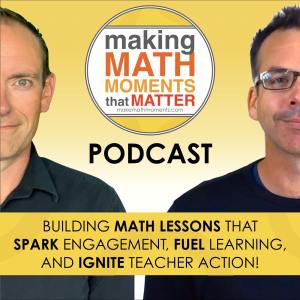
Apply to be a Featured Interview Guest
Book a Mentoring Moment Coaching Call
Are You an Official Math Moment Maker?
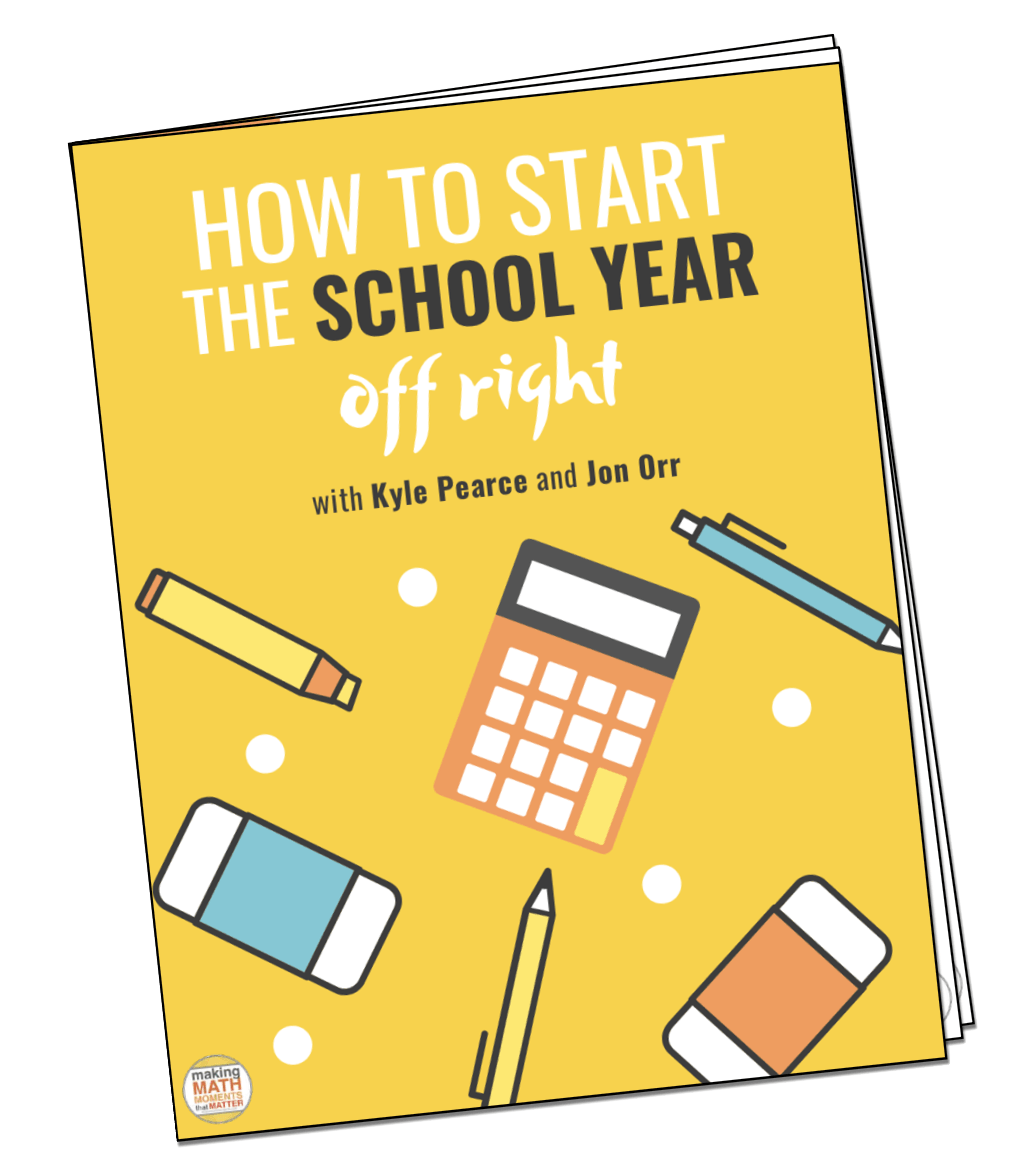
FULL TRANSCRIPT
This episode’s gonna be released sometime in August and here in Ontario it’s still summertime for us. Officially. You know, we don’t go back until after Labor Day. Right.
And then I know some of our American friends will be listening and they’re thinking, well, we’re already fully back into the swing of things, but I’m very fortunate. My family’s home for the summer, my husband and my son. And same with you, John, you have the whole family together over the summer. And this year, my husband suggested that we do a board game marathon. So our goal for the summer is to play 64 different games. you know, board games, card games, like so far, you know, chess, cribbage, It’s the March Madness of board games.
It is exactly. are creating brackets and we’re going to, you know, bring it down to our final floor and ultimately our favorite game to play as a family.
Now, we’re gonna get geekery here about, you know, Final Fours, but how did you seed your bracket? Are you just like throwing, you know, Parcheesy up against Cribbage? are you like, of a sudden, Pandemic is gonna all go head to head against, you know, Crazy Eights.
It’s pretty random. Yeah, it’s pretty random. So my son is creating our brackets. And so basically it’s getting loaded by the order we’ve been playing in. Yeah. So it’s going to be kind of random. We might lose some winners.
You all of a sudden it’s like that could have won out because it just got a bad seed.
It did. It could have made the final four, but unfortunately it was up against a favorite early on. You’re right. So maybe we’ll, you know, look at a different strategy.
I know we want to talk about this and how it relates to our math classrooms. You know, our listeners right now are like, well, board games, we know there’s a huge connection to classroom and math and thinking. So we’ll get into that. But before we do, I want to hear like, what do you hope wins?
that’s a great question. We basically decided that we can only pick one, the three of us. have to, it has to be unanimous. And so that’s going to be tricky.
So right now, like let’s say you, you are all 60. it up to me. Yeah, yeah, what do you hope?
It’s actually one of the games that I was going to talk about today as being one of my favorites in the math classroom, which is Rummy Cube. It is my favorite game.
Rummy cube. I have you know what? Okay. Well, I have never played this game. So we’ll have to get a good dig in. I love it. All right. All right. So let’s let’s get into board games obviously board games because of the the thinking because of their their natural decision-making because of the work, you know the the the level of of sometimes sometimes complexity
board games can be essential components to having that tool sitting in your classroom for various reasons. That’s what we want to talk about here today. I know that you use board games in your class. I have used extensively board games in my classrooms. We’ve talked about board games here on this podcast before many times. We’ve also had creators of board games here as guests on the podcast.
Let’s dig into it with one of our favorite topics to talk about, Yvette, board games, classrooms, what’s your experience?
I was actually, just as I was playing through a lot of these games, reminded of the ones that I really love for the classroom, but also how I introduced them in the classroom. And so it might be the first week of school for you, second week of school as this episode is airing, or you might be just a few weeks out. And so we wanted to remind you of how to maybe leverage those first few weeks to establish this culture in your classroom and also to teach these games. Like how do you
get the games into the classroom in a way that they are part of the culture, part of what we do during math class. So whether that’s during your centers, they might be an option or a choice for students while you’re working with your small groups or early finishers that have extra time. It’s just without even being asked, they just know that an option is always to go and pick up one of these games. But how do you establish that?
What are the first steps you need to take in those first few weeks to first of all establish that playing games is part of our math classroom culture, but how do you also build the capacity of the students in the room to know how to play all of these games?
Yeah. Yeah. I’ve always been a big fan of like that first week. We’ve got a resource on, on how to kick off your school year without a hitch. You can head on over to make math moments.com port slash start. That resource there has a number of resources on how to, you know, what your first week could look like. What, what are some of the resources? What are those activities? And we, we often include an inside those resources. And the way that I’ve done this in my say high school classrooms has always done a, a, a version of, of puzzly type games.
in the beginning for, in that first week for various purposes. One specific purpose is so that we can talk about what good group work looks like. Like what does a good player, our teammate look like? Because I think I always chose puzzly type games that were collaborative. Games that were working as a team to accomplish a goal. And there are lots of tabletop games and other games that allow you to say work collaboratively as a team to accomplish a specific goal.
And I love that about that first week, when we reflect on the actual game or the actual puzzle, and then we can talk about like, what goes into good group work? Like, how do I be a good group work member? Because that’s going to be the foundation of one of our pillars here in math class on collaboration. How do we work with each other? How do we get along with each other? What are those elements? We develop a rubric out of that usually. What about you?
typically use the first week to introduce my five favorite games and I do it in small group. And the reason that I choose to do that in small group is twofold. It’s an opportunity to sit with kids in a small group, get to know them because again, I’m establishing relationships. So now I have four students at my, you know, small group table and we’re playing a game together. So there’s, you know, a dynamic there where it’s fun, it’s safe.
And so I like to spend that time with them. So I spend about 20 minutes with each of my groups to teach a different game. Again, it’s like relationship building with those students, but then they are the ones who now own that game in two different ways. They own it in the sense that I then challenge them to go and teach it to other students. So it’s like, I’m like, teach three friends how to play this game by the end of the week. That’s your goal. That’s your mission. You know, this is what we’re trying to achieve. They are also responsible for making sure the game.
remains organized and put away and they check the pieces once a week. basically it’s like I teach them the game. I ask them to teach others the game, but I also say, can you keep track of the game? Can you do an inventory of the game? Can you make sure that it’s put away? And I do that four more times that we essentially have five games in the classroom that somebody knows how to play, but in that somebody is responsible for.
Got it, got it, yeah. Now this is, some teachers out there listening right now is like, okay, so give me the logistics there. Imagine I have my own set of games that I really love to use in the classroom or could use in the classroom. Small group, introduce, 20 minutes, you’re playing the game with them. The logistics, that teacher myself is going like, why is everybody else?
For sure, yeah. And ideally, it’s, you know, over time, what you do during your small group becomes more structured. But typically in the first week, right, when I haven’t established necessarily all of my centers or my norms, usually other students are just doing something independent during that time. So, and usually there’s choice. I typically provide choice anytime I’m working in small group for everybody else.
because otherwise I have to manage behavior or people are coming up to me constantly. So during that time, it’s like maybe I’ve already established an art project for the week. That’s another trick I’m going to share with new teachers. I always introduce an art project on Monday and students, I don’t have an art block necessarily. do my introduction, my explicit teaching, but then the actual work period happens throughout the week and they submit on Friday or the next Friday, depending on the scope of the project.
Yeah, I love that. That’s a great point.
Pro move, yeah? and so that it’s not like a hundred minutes of visual art. Those hundred minutes are maybe split up over 15 minute work periods or 20 minute work periods throughout the week. So maybe they’re working on their art, maybe they’re doing independent reading, maybe they’re on a digital tool to strengthen their math fluency.
And that’s a great move. I did the same, but I was not a generalist teacher, right? So I didn’t teach all subjects. taught middle school up to high school and I taught only math. So it’s like, oh, okay, so what do I do? in that case, how do I maximize small group time when I’m all like, what does that project look like? And like one of the things that we did for a long time in the last half of our teaching careers was
And we’ve talked about it many times here on the podcast too, as we call them growth days. And as I always introduced the idea of continual improvement early in that first week to say, here is our portfolio. Here are say the goals that we’re working on over the next few weeks. Here are say opportunities like choice. There are opportunities to demonstrate learning in, say on that portfolio. And it was always preloaded with some things ready to go so that
when we had small group time, when we had time where it was like, we have choice, now it’s like, look at your portfolio, pull it out. What are we working on from the portfolio? You get to choose which of these say learning goals to strengthen or practice or demonstrate and put into your portfolio so that when we had time like this, everyone’s working on something that they got to choose. And it was just for me, everyone was always working on math, whether we’re doing games in one station, but someone else is working on say,
strengthening up their fluency strategies around integers.
Yeah. And I think that this is the challenge, right? And I think that one of the barriers that we struggle with is always the question of what everybody else is doing. But the reality is we have to find a solution to that because meeting with students in small group or one-on-one is a non-negotiable for an effective math program. So these are the things that we need to establish or overcome really early in this journey, you know, and establishing a culture that I will be working with small groups.
during that time, this is what it looks like for you, these are your responsibilities. And of course, know, classroom management varies from school to school, class to class. And this may be, maybe five minutes is all you can offer right now, or 10 minutes, and then you’re losing the room and you have to, you know, get back out there. But even five minutes is better than, like I could teach a game in five minutes. You know, depending on the complexity of the game. And then I could say to that group, okay, I’m gonna explicitly, you know, teach this, I’m gonna leave you. And this is another tip I was gonna suggest.
I always, and actually this is, I think it was Kyle and our math coaches who came up with this idea that on the top of the box, we have a QR code for a very student friendly video on YouTube of how to play the game. So that if they forget or they need another reminder, they can quickly watch that video as well as, you know, the instructions, of course, in the box.
Yeah, that makes sense. makes sense. Now, when we think about what is everyone else doing, because the other question that comes up specifically, I think, when we think about games is to say, because I know that you’re going to share some of your favorite games, but the other question that I comes up is like, do we have time to play games? Is games part of my curriculum? What standards am I hitting if I’m bringing in games? And I think it’s like, am I?
Am I looking at content standards? Are there other standards that we’re prioritizing here? Like, talk to us about making the case that games make sense.
We could go, we could do a whole episode on That’s what this episode is. mean, just this topic alone, there’s a lot of brain science out there right now. We talk about the science of math and there’s actually a significant amount of research in brain science about the benefit of games and how, again, it’s almost like we are doing ourselves a disservice and our students a disservice if we don’t, because there’s so much learning. And if we look at the process expectations here in Ontario, where we look at the student practices and
the common core. What do we want? We want problem solvers, want critical thinkers, we want good communication skills, we want students who can reason and strategize and that is what games promote but in a really safe and engaging format. I mean, just I can’t imagine
a scenario where I could, especially as a general teacher, right? A home, and that’s my experience. I was a homeroom teacher. I had my students all day with the exception of prep periods. I can’t imagine a scenario where I couldn’t make the time somewhere, you know, where I just think that the benefit outweighs the, because there’s always time, right? Where students need to be engaged while you’re working in small group or you have early finishers and you want to, you know, this group still needs more time. So I think, and that’s where we help with
classroom management. Where classroom management goes off the rails is when there’s nothing to do or students are disengaged. And so making sure that we have this culture established really early on, I think is not only helpful for classroom management, but it does allow students to access those higher level critical thinking skills that we’re so desperate for in the math curriculum.
percent because it’s like we often look at the content standards as like the here in Ontario we call them curriculum expectations overall expectations specific expectations as like this is the everything but the process standards the the you know the student practices they’re there too like and we we tend to lump them in and it’s like well some of these will come out in my lessons
And therefore, a lot of times as we treat the process standards just come along for the ride, whereas the way that I view it now and the way that I viewed it for the last 10 years I’ve been teaching is that the content standards are really like a vehicle for you to get to more of the process standards, like to more of the reasoning and the proving, the more the problem solving, the more of the justification, the more of the productive disposition.
one of the proficiencies for math. Like those are really what we’re trying to do. Like those are the whys of what we’re doing in our math class. Like why are we teaching math? Those things. And the games hit at that primarily. So when you think about like, do we, have time to do games while you’re still responsible to teach and eval, you know, and also assess on those other standards. And it’s just, we, we kind of put them as like secondary standards and not primary standards. And, and I think that.
that goes a long, long way to like start to equalize and normalize that it’s, it’s fine to work on that because actually when you do work on those, it strengthens the other standards anyway. Like you’re going to get farther with your lessons if you’re strengthening these standards throughout your year, because I think we just pushed them to the side because we don’t have time, but actually if you make time, it actually saves you long range time.
And one ability that we haven’t even touched on yet is spatial. Spatial reasoning is, we’ve talked about this before, it’s a huge indicator of later mathematics achievement. And what better way to build spatial reasoning than through puzzles and games? I can’t think of a better way. And knowing that it’s so critical for being able to visualize math down the road, I can’t advocate enough for why I believe this is time well spent.
We’re trying to make a case. gotta get it aside whether this is the right move for you. Does it serve your why or not serve your why? We make it part of the work that we do in our classrooms. All right. What are the games? Give us.
Okay, so it was hard. I came up with my top three. So I already mentioned Rummikube. So Rummikube is similar to the card game Rummikube except that you play with tiles. So everybody loads their tray with 14 tiles. And basically you can play, you know, sets of the same number. So, you know, I can play three fours or four fours. The minimum number in a set is three or I can do a straight. And again, the minimum set is three.
So I could do four, five, six. They call them melds in that game. And basically your very first meld that you play has to be at least 30 points. So I can’t play until I have a value of 30, but here’s where things get so complicated. Once all of the melds are out on the board, I can take other melds apart to make new ones. As long as there’s always three tiles.
So like the three is necessity, but basically let’s say somebody else put out a meld and they have an eight at the end, but I could take that eight and make three eights with my tiles. Then I can play that one. So you’re constantly looking at the board, trying to figure out what you can take apart and put back together that’s gonna benefit you because ultimately you wanna get rid of your tiles. That’s the goal of the game. It’s very hard.
Like it?
Like it really, it really challenges my brain because you have to look at all of the different possibilities that are at play. So obviously the more tiles on the table, the more opportunities there are. And so there’s a lot of strategy in that game. So that’s my, that was the one that I had said, I hope it, I don’t think it will win my bracket in my family. It’s my favorite. asked to play it all the time. I also, we all really, really love Mancala because it’s so
fast to play, but it requires so much strategy. And honestly, it requires a lot of like seeing ahead and counting. Have you played Mancala before? Okay, you should definitely get this one because it’s one that you can take with you camping. doesn’t require, it doesn’t take up a lot of room, but essentially you have a tray and it has 12 spaces and you have stones in the spaces. And basically you’re trying to get
Not.
all of the stones by counting into your end of the board. And so you can imagine it’s like, and basically it’s like, you need to end in that spot. And then like, so if I pick up, if I’m three away and I pick up all three, I drop one, two, three, that one lands in my spot. And so I’m constantly thinking, and what you don’t want to do is land in an empty spot because then it changes to the other person.
So, Mancala is a, I think it’s like a traditional game. The only problem with that game, a barrier, is that you lose the stones very quickly in a classroom, but it doesn’t matter. You can replace them with anything. Like, I’ve seen some people replace them with like dried beans. Like, it doesn’t need to be the stones. It can be, you know, cubes from your math kit. It doesn’t have to be the stones, although the stones have like a satisfying feel and sound. So, that’s my other one. My last one, which is…
you know, probably very familiar to most math teachers is blockus, but I recently got blockus 3d, which was a game changer. It’s awesome.
We are a blockers family.
Okay, Blockus, so is Leto is amazing at Blockus and he we’ve played with him, you know, every variation we now have Blockus 3D. So imagine now your blocks are three dimensional and you’re trying to there’s different I guess like outlines to place on the board and you’re trying to when you look at it from the top view by the end of the game you want your color to cover the greatest surface area.
Interesting.
Yeah, you can, depending on how many players you have, it limits the height of the structure. So if it’s two player, you can only go four rows high. But, you know, you have to imagine like you’re trying to strategically place pieces into this three-dimensional structure by making, and making sure that you are not covering up your own color. Because you want to have the greatest surface area. Yeah, block is 3D. It’s my new, one of my new favorites.
Interesting.
Love it, love it, yeah, no. I’m put that on my list to have a peak at. Some of the games that I played primarily in our classroom, I think we’ve shared here on the podcast before, is like we, I’ve played them in two different versions. One is when small groups get together and play each other. But then also we play them as a class, you know, sometimes to kick off the day or to end the day, you know, at certain times as a whole group. Sometimes me against the class, sometimes.
you know, maybe a student against the class when we play whole class. So one of those ones that was a regular, a staple in our classroom was skunk. And I don’t even know if that’s the actual name, which was the dice. You roll, know, everyone stands up and, or even your small group, you’re standing up, or you’re making an indicator to say when you want to like opt out of the game, which is basically saying like, we’re going to roll the dice. If we roll a one, the game ends. If you’re standing, you’ve lost points and you gain points by just saying.
I’m gonna keep standing and if I don’t roll a one, then we add whatever the total is to my communal score. And so it becomes a game of round by round by round. You play like five rounds. Whoever has the most points at the end is the winner. And it’s like a kind of a kickoff. Kids love to play this game, whether at the end of class or you start a class. We should play it once a week with our group, either as a whole class or in small group for sure. Skyscrapers is kind of that puzzle-y type game we used to play in the beginning of the week.
It’s more puzzly, communal community. it’s like, here’s a, here’s one, one puzzle. And if you want, we’ll, you know, put these games in the show notes. So you have links to them or resources to have a look at, but, but, skyscrapers being like that. Let’s, let’s make sure that we, we fit where these tall buildings or these, these, various, you know, sizes of buildings can fit on the scale based on some criteria that we have to have to hit.
always kind of a favorite to play in say teams together. Another one that we played was I got this off of Sarah Vanderworth, which was the five by five game. And the five by five game was you have 25, say playing cards and you shuffle them up and kids have the five by five grid, say on their desk or, maybe they’re playing, they got a little, little card that shows five by five grid. And when you draw a card and then we’re only playing like numbers two to two to 10. So you’re just putting
25 cards, just numbers in there. And whatever card you draw, you have to write that in a square in your grid. And then depending on where you put side by side numbers, so repeating numbers, like if it two tens together, all of a sudden you start, you get to add some points together. So it was a strategic game to say collect the amount of, the most amount of points at the end, or you can play variations, like whoever gets the least amount of points or the closest to 50 or closest to a particular number was a variation on that game. But five by five was a,
A common game we played either in small group, but also in the large group together as a class. I think one, one of the ones that’s like not really a tabletop game, which was a game that we always played as a, as a whole group was 20 questions. It was like a Friday staple in our classes that I would choose an object in the classroom and kids. And as a team had 20 questions to try to narrow down what I had chosen and we would keep a running tally and then we flip it. I would step out of the classroom.
And they had, so someone or together they would choose something in the room and I would come back in and have 20 questions to try to narrow down and choose the object that they selected. And it was always fun to take time to kind of do that questioning and the wondering and talk about, you know, criteria and, and in narrowing down qualities, all that kind of thing. So that was some of our go-to games that weren’t necessarily tabletop games, easy games to play in our math class, whether small group or whole group.
Hopefully we made the case here that games are important part of your math class. Whether they are hitting your standards or whether they’re strengthening the math practice process is why we’re choosing to play those games. So what are your favorite games? We’d love to hear. Hit reply on any emails you get from us or reach out to us so that we can learn more games that maybe we’ve missed along the way or maybe that you’ve got a game changer.
for your classroom, but let us know. We know that playing games can strengthen any of the six components of an effective math classroom in your math classroom tree. You wanna learn more about those six in the tree, head on over to makemathmoments.com for slash report. And take that quick assessment to figure out which part of the tree you wanna strengthen next.
Thanks For Listening
- Book a Math Mentoring Moment
- Apply to be a Featured Interview Guest
- Leave a note in the comment section below.
- Share this show on Twitter, or Facebook.
To help out the show:
- Leave an honest review on iTunes. Your ratings and reviews really help and we read each one.
- Subscribe on iTunes, Google Play, and Spotify.
DOWNLOAD THE 3 ACT MATH TASK TIP SHEET SO THEY RUN WITHOUT A HITCH!
Download the 2-page printable 3 Act Math Tip Sheet to ensure that you have the best start to your journey using 3 Act math Tasks to spark curiosity and fuel sense making in your math classroom!
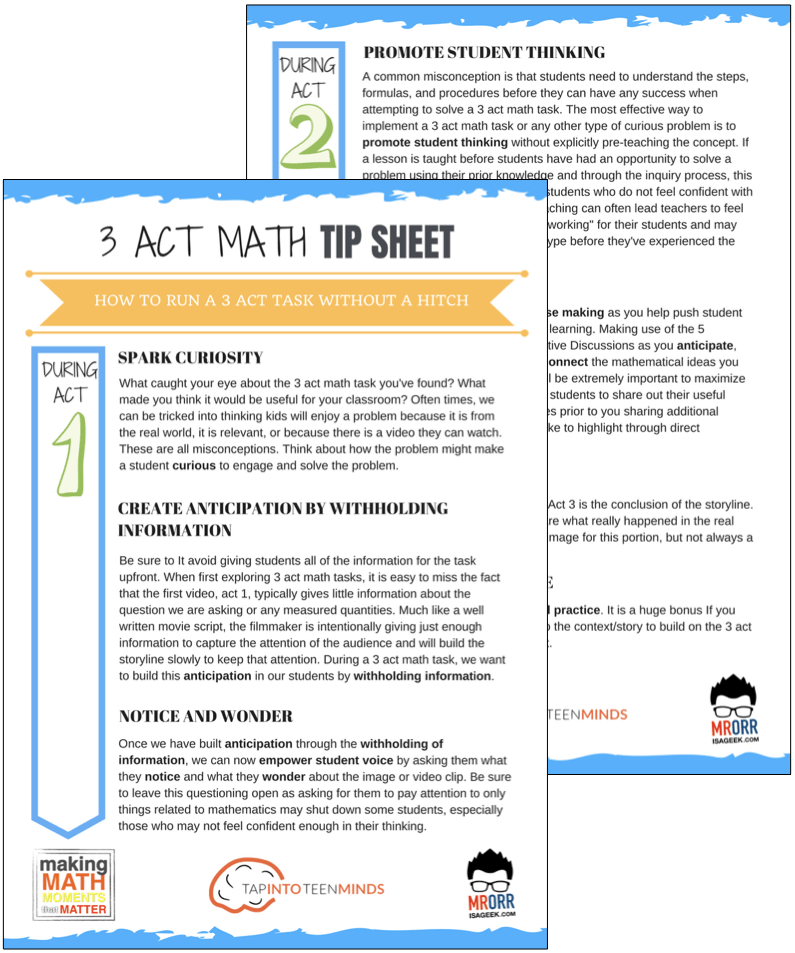
LESSONS TO MAKE MATH MOMENTS
Each lesson consists of:
Each Make Math Moments Problem Based Lesson consists of a Teacher Guide to lead you step-by-step through the planning process to ensure your lesson runs without a hitch!
Each Teacher Guide consists of:
- Intentionality of the lesson;
- A step-by-step walk through of each phase of the lesson;
- Visuals, animations, and videos unpacking big ideas, strategies, and models we intend to emerge during the lesson;
- Sample student approaches to assist in anticipating what your students might do;
- Resources and downloads including Keynote, Powerpoint, Media Files, and Teacher Guide printable PDF; and,
- Much more!
Each Make Math Moments Problem Based Lesson begins with a story, visual, video, or other method to Spark Curiosity through context.
Students will often Notice and Wonder before making an estimate to draw them in and invest in the problem.
After student voice has been heard and acknowledged, we will set students off on a Productive Struggle via a prompt related to the Spark context.
These prompts are given each lesson with the following conditions:
- No calculators are to be used; and,
- Students are to focus on how they can convince their math community that their solution is valid.
Students are left to engage in a productive struggle as the facilitator circulates to observe and engage in conversation as a means of assessing formatively.
The facilitator is instructed through the Teacher Guide on what specific strategies and models could be used to make connections and consolidate the learning from the lesson.
Often times, animations and walk through videos are provided in the Teacher Guide to assist with planning and delivering the consolidation.
A review image, video, or animation is provided as a conclusion to the task from the lesson.
While this might feel like a natural ending to the context students have been exploring, it is just the beginning as we look to leverage this context via extensions and additional lessons to dig deeper.
At the end of each lesson, consolidation prompts and/or extensions are crafted for students to purposefully practice and demonstrate their current understanding.
Facilitators are encouraged to collect these consolidation prompts as a means to engage in the assessment process and inform next moves for instruction.
In multi-day units of study, Math Talks are crafted to help build on the thinking from the previous day and build towards the next step in the developmental progression of the concept(s) we are exploring.
Each Math Talk is constructed as a string of related problems that build with intentionality to emerge specific big ideas, strategies, and mathematical models.
Make Math Moments Problem Based Lessons and Day 1 Teacher Guides are openly available for you to leverage and use with your students without becoming a Make Math Moments Academy Member.
Use our OPEN ACCESS multi-day problem based units!
Make Math Moments Problem Based Lessons and Day 1 Teacher Guides are openly available for you to leverage and use with your students without becoming a Make Math Moments Academy Member.
Partitive Division Resulting in a Fraction
Equivalence and Algebraic Substitution
Represent Categorical Data & Explore Mean
Downloadable resources including blackline masters, handouts, printable Tips Sheets, slide shows, and media files do require a Make Math Moments Academy Membership.
ONLINE WORKSHOP REGISTRATION
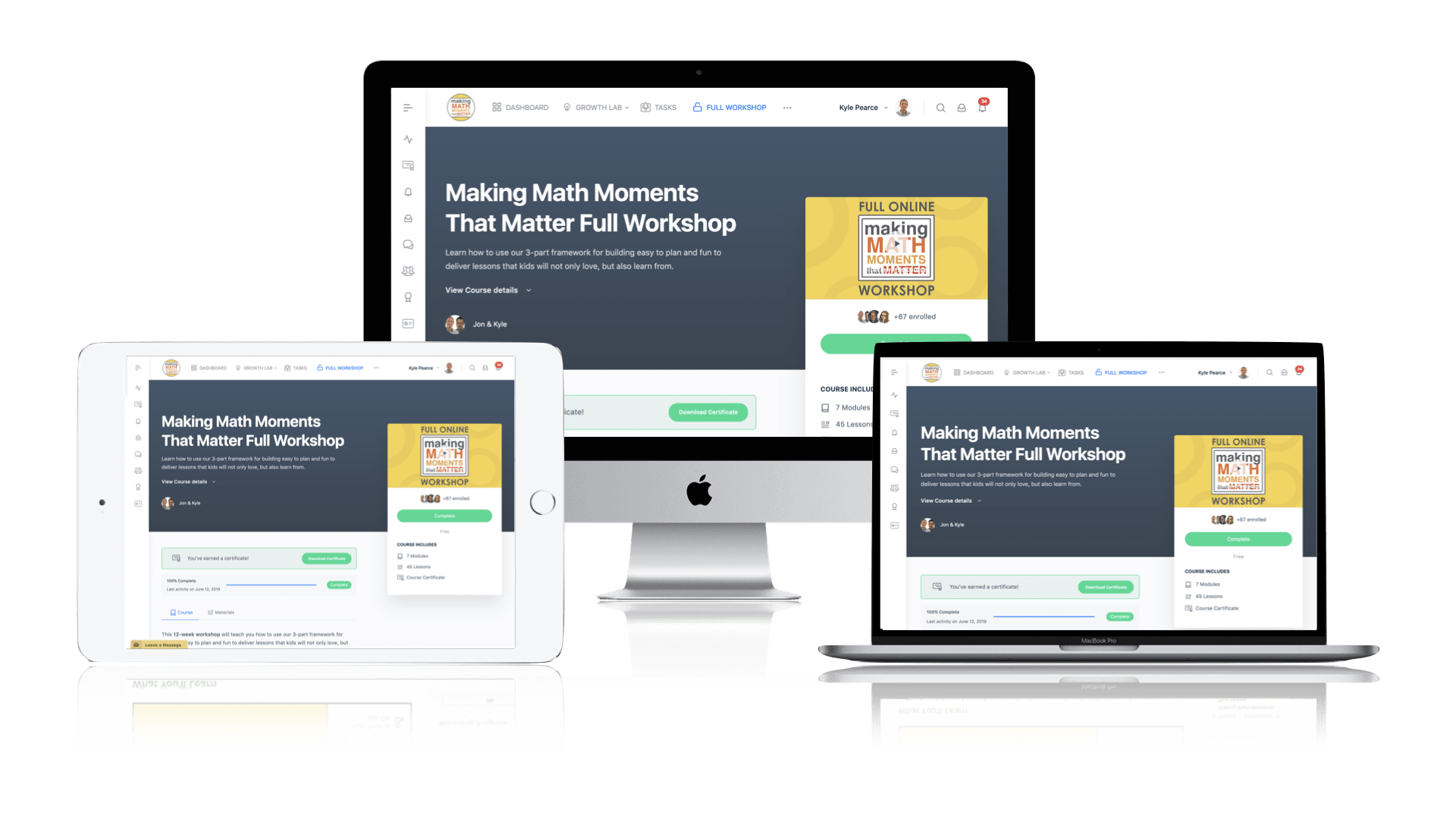
Pedagogically aligned for teachers of K through Grade 12 with content specific examples from Grades 3 through Grade 10.
In our self-paced, 12-week Online Workshop, you'll learn how to craft new and transform your current lessons to Spark Curiosity, Fuel Sense Making, and Ignite Your Teacher Moves to promote resilient problem solvers.
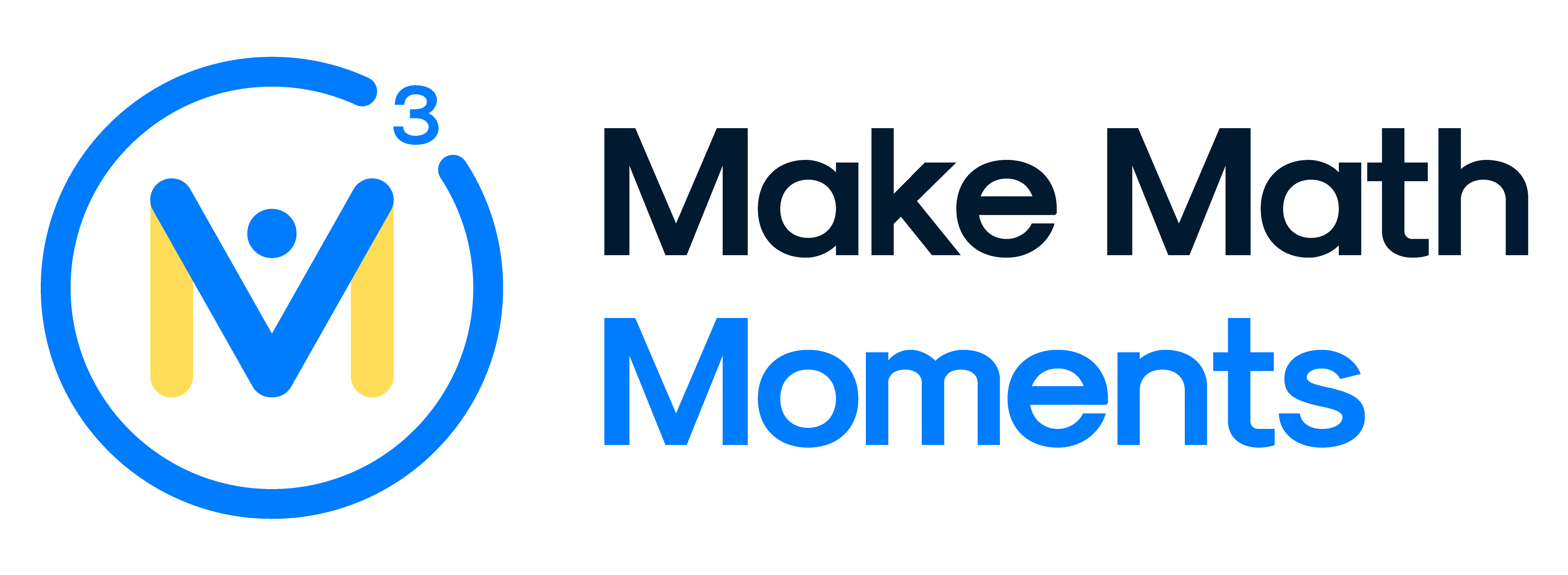



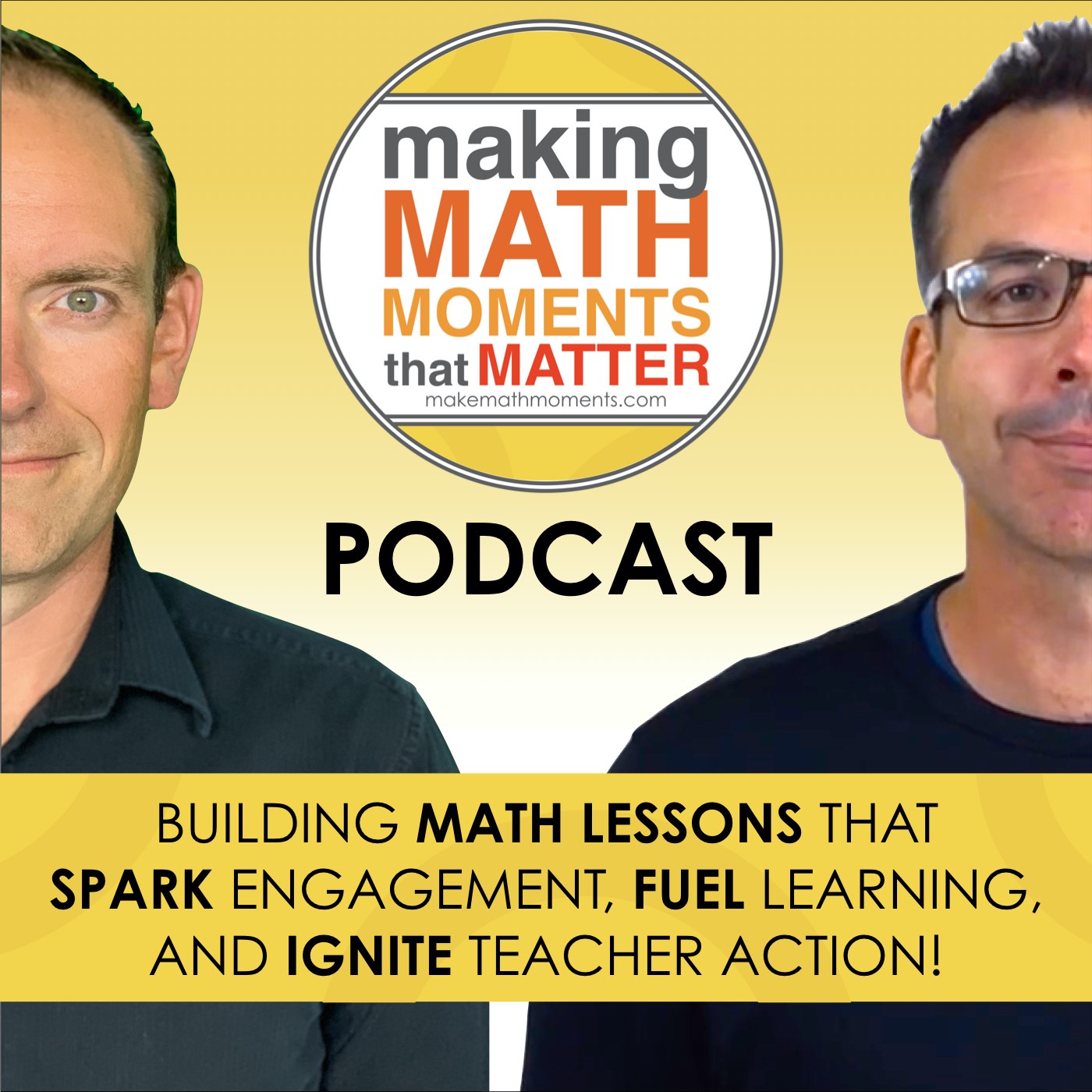
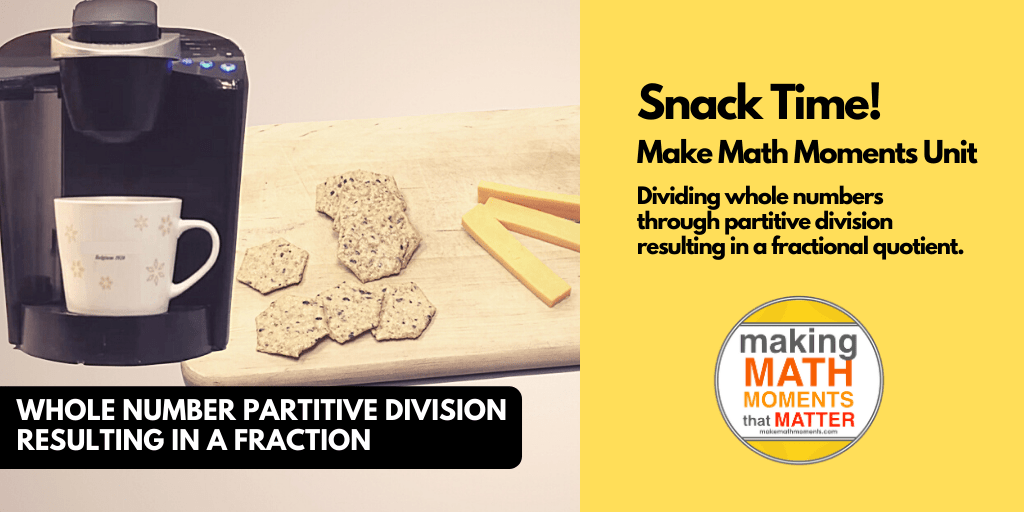

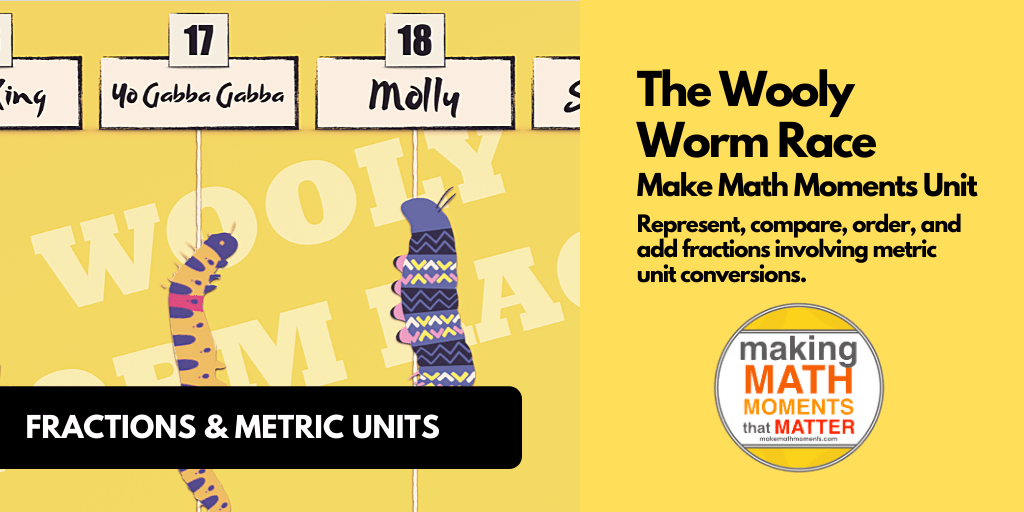
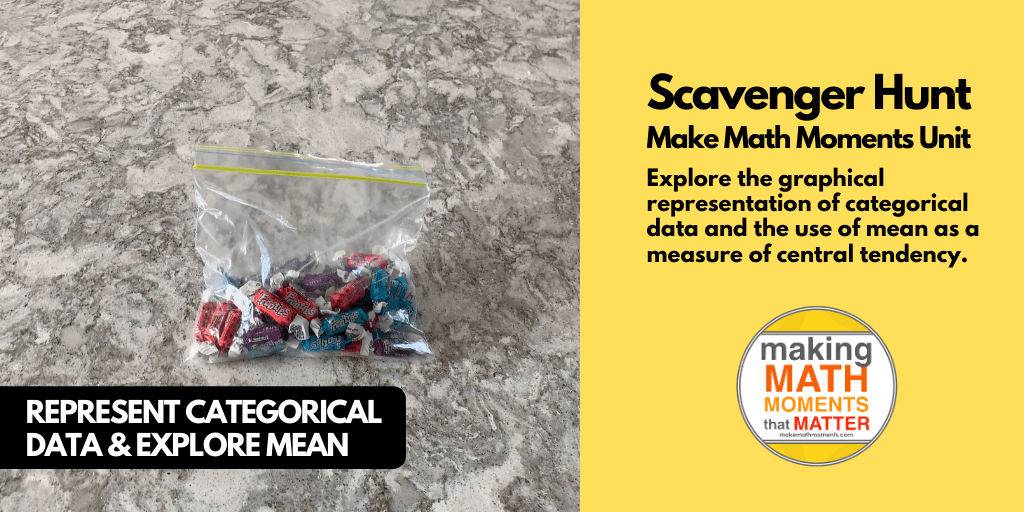

0 Comments